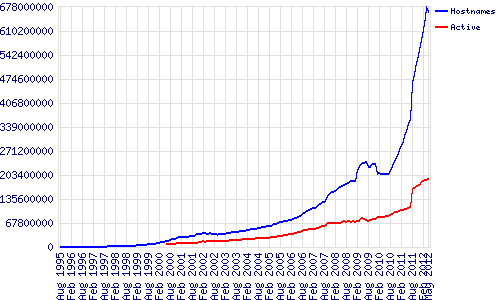If there is a commandment in digital marketing, it’s Content is King, with good reason. Relevant content is a brand’s most valuable asset.
But it would be mistake to believe that is all you need. As of May 2012, there are 650 million websites; 203 million are active websites and, according to this chart from Netcraft, they are growing in leaps and bounds.
The good news is your audience, and Google, love quality content and, if you provide it on a regular basis, you will see your search rank rise.
Sure, Content is King but, if you want your kingdom to get found, here are 12 SEO steps to take.
KEYWORDS
- SEE WHAT THE SEARCH ENGINES SEE IN YOU: If you have an analytics tool like Google Analytics, look at the keywords and key phrases people use to find your site. For example, on this site, there are roughly 150 case studies that prove ROI in areas like social media, CRM, social commerce and customer service. “Case studies” is one of the most often used phrases people use to find this site. We are interested in an audience that is interested in marketing case studies, we’ll keep writing these blogs. It attract both a desirable audience and the search engines.
- KNOW WHO TO ATTRACT: For every business, there a wide disparity between best and worst customers. Google Analytics can tell you, for example, where your audience comes from (e.g. Search, Facebook, Twitter, LinkedIn, Direct), how much time each group spends, how many pages each group views so you can write to the people that matter most and attract more of them.
- LOOK AT THE COMPETITION: Competitive analysis tools like Compete and Alexa give you much of the information in the above points for your key competitors. This gives you an understanding as well as ideas on what to write about vis-a-vis key competitors.
- CREATE YOUR “SEED” LIST: Now, you’re ready to look for the single words (short tail) and multi-word phrases (long tail) you want for your business. Using search tools like Keyword Tracker, Google AdWords Keyword Tool and SEO Book, you can easily create lists that show search volume and competitiveness. You have built a foundation for your content kingdom.
COPYWRITING
- WRITE FOR YOUR AUDIENCE, NOT SEARCH ENGINES: Your audience, not the search engines, is your end user and they expect you to educate and inform them before they buy. So, use keywords and key phrases that are conversational as you would talk to a person, not a search engine.
- RECOGNIZE DIFFERENT TYPES OF READERS: There are three types of readers: 1) Researchers, 2) Shoppers and 3) Buyers. Researchers want general information in laymen’s terms; shoppers want comparisons and buyers want specific terminology and facts. All are important because each plays a role from building outreach to generating revenue. So know who you are talking to and why.
- APPEALS TO NEEDS, ASK QUESTIONS AND INFORM: Although there are different types of readers, they all have in common unmet needs that you can appeal to by asking questions and providing information.
- WRITE DESCRIPTIVE CONTENT IN A NATURAL FLOW: This is a difference between these statements: 1) Look here for the latest ROI cases studies in social media, CRM and social commerce and 2) We show you case studies for a business similar to yours that is proving return on investment (ROI) and growing their bottom line using social media, CRM and social commerce. Both say the same thing and use the same keywords. One talks at you; one talk to you, says what’s in it for you and encourages you to get involved. Which one is more convincing to you?
SITE OPTIMIZATION
- DON’T PUT ALL YOUR CONTENT EGGS IN ONE BASKET: It important to know the keywords and key phrases that drive your audience to your website. It’s equally important not to put them all on your homepage so they don’t compete for your reader’s attention and the search engines.
- PLAN EACH PAGE OF YOUR WEBSITE AROUND A CORE PIECE OF CONTENT: If you plan a page for each piece of core content, you build a kingdom for your content that is far reaching and strong.
- HAVE A PLAN FOR PROMOTING CONTENT: Blog at least once a week, publish content on social networks and optimize your website for mobile. These are “best practices” for sharing content which studies from HubSpot show increase website traffic +30% or more. A good place to see how you are doing is HubSpot’s Website Grader.
- TRACK, REPORT, OPTIMIZE AND REPEAT: Let the same tools that helped you at the start, keep your strategy on track and improve. You’ve created your kingdom. Now, be a kind, compassionate and prolific ruler.
Does this teach you something new about how to use content to attract an audience to your kingdom?







[…] Ad Group Ideas (Beta) – New Google Adwords Keyword Tool FeatureThe importance of Google adwords keyword tool in keyword researchGoogle AdWords Keyword Tool Update: Adds New Features & Changes UIGoogle Adwords Keyword Tool RedesignedGoogle Adwords Keyword ToolSEO Mistakes You Must Avoid – Strategies To Help You Do ThisHow to Make a SEO Strategy for Your Professional BlogNEIMSGoogle Search Engine OptimizationContent is King.12-steps to build your kingdom […]
[…] Content is King.12-steps to build your kingdom […]
Rob: Good and useful stuff. Just downloaded and printed so I can have a handy reference when interviewing people who claim digital savvy…P
[…] And, finally, Rob Petersen explains why content is king and the 12 steps to ensure your content gets found. […]